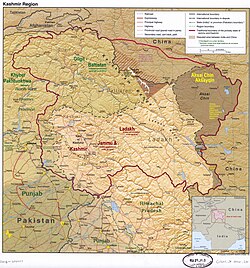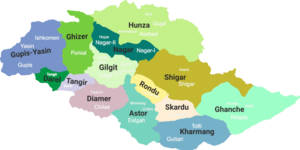| Ghizer District ضلع غذر | |
|---|---|
| District of Gilgit-Baltistan administered by Pakistan | |
 Ishkoman Valley Ishkoman Valley | |
| Interactive map of Ghizer district | |
 A map showing Pakistani-administered Gilgit-Baltistan (shaded in sage green) in the disputed Kashmir region A map showing Pakistani-administered Gilgit-Baltistan (shaded in sage green) in the disputed Kashmir region | |
| Coordinates (Gahkuch): 36°10′25″N 73°46′0″E / 36.17361°N 73.76667°E / 36.17361; 73.76667 | |
| Administering country | Pakistan |
| Territory | Gilgit-Baltistan |
| Division | Gilgit Division |
| Headquarters | Gahkuch |
| Government | |
| • Type | District Administration |
| • Deputy Commissioner | N/A |
| • District Police Officer | N/A |
| • District Health Officer | N/A |
| Number of tehsils | 2 |
Ghizer District (Urdu: ضلع غذر) is a district of Pakistan-administered Gilgit-Baltistan region in the disputed Kashmir region. It is one of the 14 districts of Gilgit-Baltistan. The former Ghizer District that existed from 1974 to 2019 spanned the entire upper Gilgit River Valley (also known as the Ghizer River Valley). In 2019, the former district was divided into the Gupis-Yasin District in the west and the present, smaller Ghizer District in the east.
History
Before inclusion in Gilgit Agency by the British, the area was part of Chitral under Kho Khushwaqt Mehtar ("ruler").

Geography

The Ghizer District is bounded on the north by the Upper Chitral District of Pakistan's Khyber Pakhtunkhwa Province and the Wakhan District of Afghanistan's Badakhshan Province, on the east by the Hunza District, the Nagar District, and the Gilgit District, on the south by the Tangir District, on the south-west by the Darel District, and on the west by the Gupis-Yasin District.
The highest peak of Ghizer District is Koyo Zom (6,871 m) (Hindu Kush Range range), which lies on the boundary between Ghizer District and Chitral.
Some of the main places in the district are Koh-i-Ghizer, Ishkoman and Yasin valleys. Other places include Gupis, Chatorkhand, Imit, Pingal, Shahmaran and Utz.
Some of the passes in the district are:
- Bichhar Pass (on the boundary of Ghizer and Gilgit Districts)
- Chillingi Pass
- Hayal Pass and Naltar Pass (on the boundary of Ghizer and Gilgit Districts)
- Kalandar Pass
The main river in the district is the Gilgit River. The other tributaries include the Qurumbar River, Phakora River, Hayal River, Singul River and Yasin River, Phander river tributary which also joins the main stream at different points.
Administration
The present Ghizer District consists of two tehsils:
The district headquarters is the town of Gahkuch.
Education
According to the Alif Ailaan Pakistan District Education Rankings of 2015, Ghizer was ranked 10 out of 148 districts in terms of education. For facilities and infrastructure, the district was ranked 17 out of 148. The biggest contribution in the region in education is "Agha Khan Education Service Pakistan"(AKESP).
Notes
- On the map, the Ishkoman Tehsil is wrongly shown as part of the Gupis-Yasin District.
References
- ^ The application of the term "administered" to the various regions of Kashmir and a mention of the Kashmir dispute is supported by the tertiary sources (a) through (e), reflecting due weight in the coverage. Although "controlled" and "held" are also applied neutrally to the names of the disputants or to the regions administered by them, as evidenced in sources (h) through (i) below, "held" is also considered politicized usage, as is the term "occupied," (see (j) below).
(a) Kashmir, region Indian subcontinent, Encyclopaedia Britannica, retrieved 15 August 2019 (subscription required) Quote: "Kashmir, region of the northwestern Indian subcontinent ... has been the subject of dispute between India and Pakistan since the partition of the Indian subcontinent in 1947. The northern and western portions are administered by Pakistan and comprise three areas: Azad Kashmir, Gilgit, and Baltistan, the last two being part of a territory called the Northern Areas. Administered by India are the southern and southeastern portions, which constitute the state of Jammu and Kashmir but are slated to be split into two union territories.";
(b) Pletcher, Kenneth, Aksai Chin, Plateau Region, Asia, Encyclopaedia Britannica, retrieved 16 August 2019 (subscription required) Quote: "Aksai Chin, Chinese (Pinyin) Aksayqin, portion of the Kashmir region, at the northernmost extent of the Indian subcontinent in south-central Asia. It constitutes nearly all the territory of the Chinese-administered sector of Kashmir that is claimed by India to be part of the Ladakh area of Jammu and Kashmir state.";
(c) "Kashmir", Encyclopedia Americana, Scholastic Library Publishing, 2006, p. 328, ISBN 978-0-7172-0139-6 C. E Bosworth, University of Manchester Quote: "KASHMIR, kash'mer, the northernmost region of the Indian subcontinent, administered partlv by India, partly by Pakistan, and partly by China. The region has been the subject of a bitter dispute between India and Pakistan since they became independent in 1947";
(d) Osmańczyk, Edmund Jan (2003), Encyclopedia of the United Nations and International Agreements: G to M, Taylor & Francis, pp. 1191–, ISBN 978-0-415-93922-5 Quote: "Jammu and Kashmir: Territory in northwestern India, subject to a dispute between India and Pakistan. It has borders with Pakistan and China."
(e) Talbot, Ian (2016), A History of Modern South Asia: Politics, States, Diasporas, Yale University Press, pp. 28–29, ISBN 978-0-300-19694-8 Quote: "We move from a disputed international border to a dotted line on the map that represents a military border not recognized in international law. The line of control separates the Indian and Pakistani administered areas of the former Princely State of Jammu and Kashmir.";
(f) Skutsch, Carl (2015) , "China: Border War with India, 1962", in Ciment, James (ed.), Encyclopedia of Conflicts Since World War II (2nd ed.), London and New York: Routledge, p. 573, ISBN 978-0-7656-8005-1,The situation between the two nations was complicated by the 1957–1959 uprising by Tibetans against Chinese rule. Refugees poured across the Indian border, and the Indian public was outraged. Any compromise with China on the border issue became impossible. Similarly, China was offended that India had given political asylum to the Dalai Lama when he fled across the border in March 1959. In late 1959, there were shots fired between border patrols operating along both the ill-defined McMahon Line and in the Aksai Chin.
(g) Clary, Christopher, The Difficult Politics of Peace: Rivalry in Modern South Asia, Oxford and New York: Oxford University Press, p. 109, ISBN 9780197638408,Territorial Dispute: The situation along the Sino-Indian frontier continued to worsen. In late July (1959), an Indian reconnaissance patrol was blocked, "apprehended," and eventually expelled after three weeks in custody at the hands of a larger Chinese force near Khurnak Fort in Aksai Chin. ... Circumstances worsened further in October 1959, when a major class at Kongka Pass in eastern Ladakh led to nine dead and ten captured Indian border personnel, making it by far the most serious Sino-Indian class since India's independence.
(h) Bose, Sumantra (2009), Kashmir: Roots of Conflict, Paths to Peace, Harvard University Press, pp. 294, 291, 293, ISBN 978-0-674-02855-5 Quote: "J&K: Jammu and Kashmir. The former princely state that is the subject of the Kashmir dispute. Besides IJK (Indian-controlled Jammu and Kashmir. The larger and more populous part of the former princely state. It has a population of slightly over 10 million, and comprises three regions: Kashmir Valley, Jammu, and Ladakh.) and AJK ('Azad" (Free) Jammu and Kashmir. The more populous part of Pakistani-controlled J&K, with a population of approximately 2.5 million.), it includes the sparsely populated "Northern Areas" of Gilgit and Baltistan, remote mountainous regions which are directly administered, unlike AJK, by the Pakistani central authorities, and some high-altitude uninhabitable tracts under Chinese control."
(i) Fisher, Michael H. (2018), An Environmental History of India: From Earliest Times to the Twenty-First Century, Cambridge University Press, p. 166, ISBN 978-1-107-11162-2 Quote: "Kashmir’s identity remains hotly disputed with a UN-supervised “Line of Control” still separating Pakistani-held Azad (“Free”) Kashmir from Indian-held Kashmir.";
(j) Snedden, Christopher (2015), Understanding Kashmir and Kashmiris, Oxford University Press, p. 10, ISBN 978-1-84904-621-3 Quote:"Some politicised terms also are used to describe parts of J&K. These terms include the words 'occupied' and 'held'." - "GB cabinet decides to upgrade Dareal, Tangir,Gupis Yasin and Roundu as districts". Radio Pakistan. 20 April 2019. Archived from the original on 19 June 2019. Retrieved 19 June 2019.
- "Individual district profile link, 2015". Alif Ailaan. Archived from the original on 2015-11-17. Retrieved 2015-05-07.